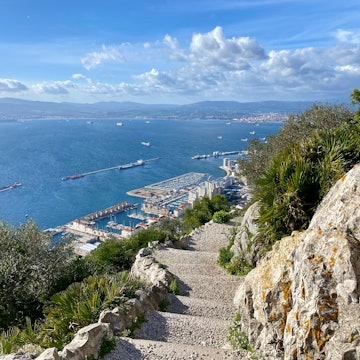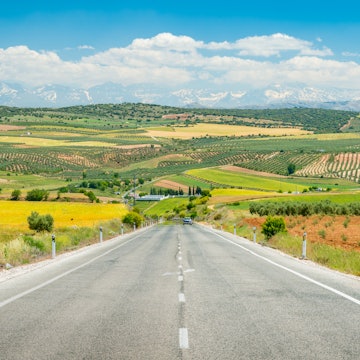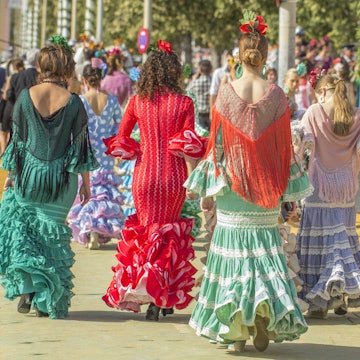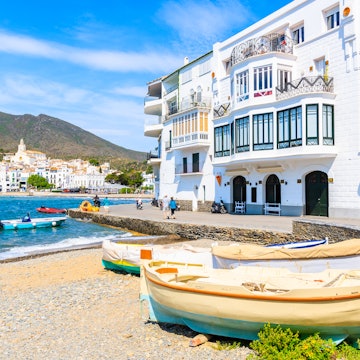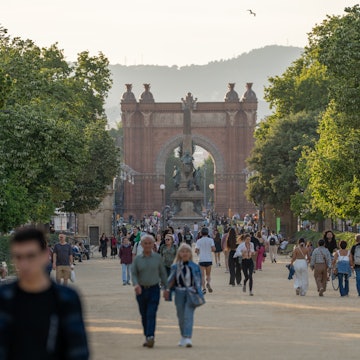

From dining out to booking tickets, here's what you need to know before going to Seville. Alena Bahdanovich/Shutterstock
Seville is the gleaming jewel in Andalucía’s cultural crown and a superb introduction to the region.
Packed into Seville’s fairly compact Casco Antiguo (Old Town) are some of Spain’s great architectural treasures (including the Real Alcázar), its most impassioned art form, flamenco, and a whole host of museums, mansions and ornate churches.
The Romans, Moors and Reyes Católicos (Catholic Monarchs of the Spanish Empire) came, saw, conquered and then left the best of themselves behind, for all to see. And because a great trip is a well-planned trip, here are all the things you should know about health, safety and etiquette in Seville before you go.
1. Plan to spend at least three days in Seville
Seville demands a proper exploration. Barrio Santa Cruz is a great place to start for first-time visitors, with three UNESCO World Heritage Sites – Real Alcázar, Catedral de Seville and Archivo General de Indias – clustered at the edge of the labyrinthine neighborhood. These sights could easily consume a couple of days on their own, particularly with the riches of the Hospital de los Venerables Sacerdotes and flamenco tablaos such as Casa de la Guitarra also packed into this tiny neighborhood. But there’s so much more to experience within easy walking distance, including scores of fascinating museums, churches and mansions. And that’s without even mentioning the food yet. Three days is the minimum you’ll want to spend here.
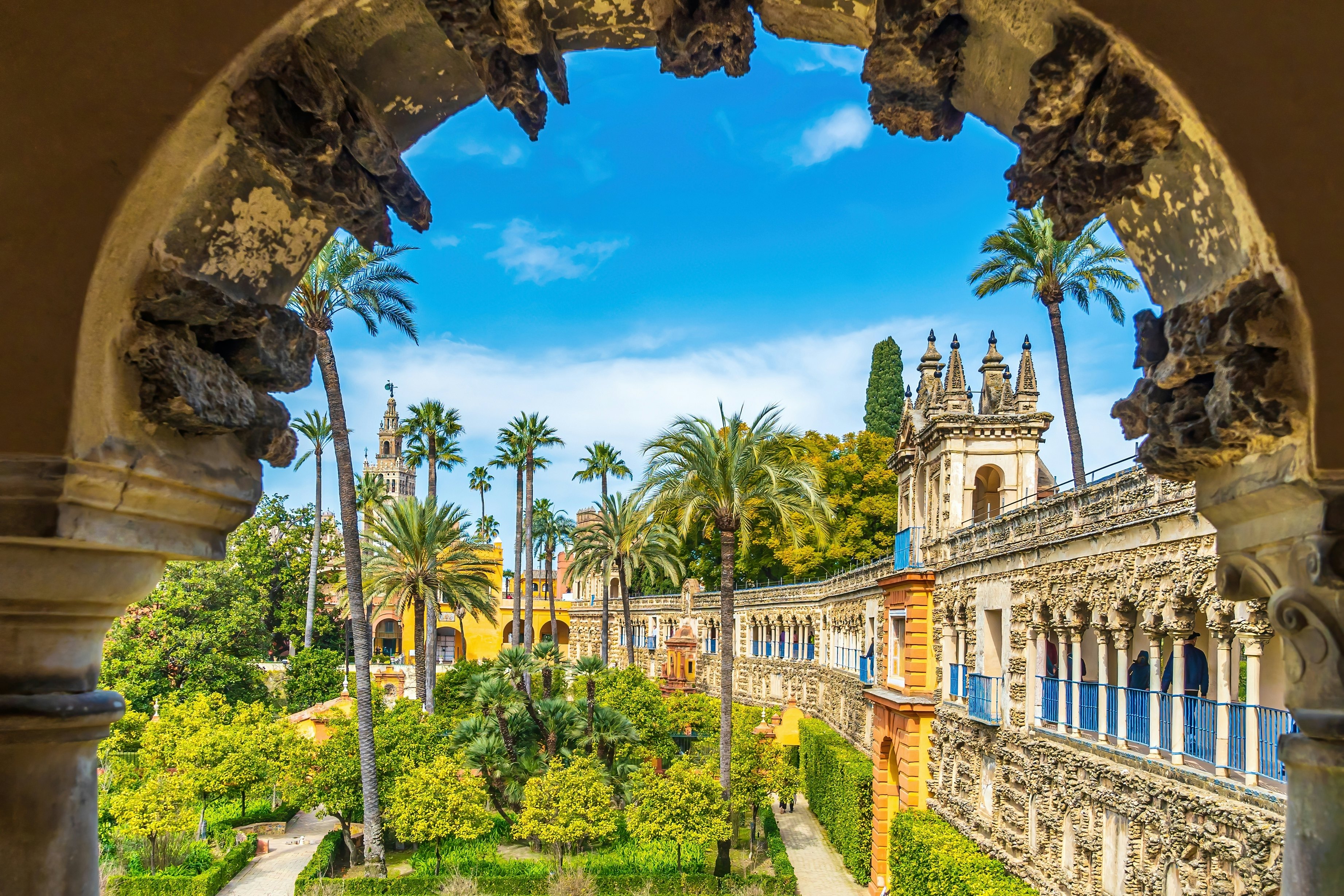
2. Avoid visiting the cathedral and Real Alcázar on the same day
Although it’s tempting to pack all three of Seville’s UNESCO World Heritage sites into one long day, it’s not advisable if you want to experience them properly. Both the Catedral de Sevilla and Real Alcázar are accessible via a specific entry time ticket only (turn up early or late and you might be turned away). It’ll be less fun visiting the first site if you know you have to hurry through it to make it in time to enter the second site. They are also both vast places that demand a lot of walking and standing. The Real Alcázar and its gardens need at least half a day to explore thoroughly. The cathedral is one of the world’s largest and its Giralda is accessed via an approximately 100-meter climb, which is extra draining if you’re visiting during hot weather. The Archivo General de Indias, however, makes for a perfect second sight to see on day one, before tackling either the cathedral or Real Alcázar fresh the next day.
3. If you’re on a budget, try to grab the free tickets to major sights
Each week, Catedral de Sevilla offers free visits on Sundays. The tickets allow access to the cathedral and Giralda tower, between 430-6pm, excluding religious festivals and can only be secured on the official cathedral website. Unsurprisingly, demand is monumental and they often get snapped up very quickly, so you might need to try a couple of times.
Similarly, the Real Alcázar has free entrance for an hour on Mondays. Reserve these free tickets on the official website for entry from 6–7pm between April and September, and from 4–5pm between October and March.
4. You don’t need to avoid high summer, you just need to prepare well
One of the great things about Seville is that there’s never really a bad time to visit. While some blogs will advise to avoid July and August, the reality isn’t all that bad. In fact, the old city was designed and laid out to keep most streets in the shade throughout the day. Most hotels have air-conditioned rooms and the advantage of visiting when most people are scared away is that you will bag some bargain prices for hotel rooms right in the Casco Viejo. If you’re happy to work an afternoon siesta into your itinerary – when many places are closed anyway – you can still make the most of the mornings and evenings to explore. But don’t forget to bring sunglasses, a hat and sunscreen, and drink plenty of water throughout the day.
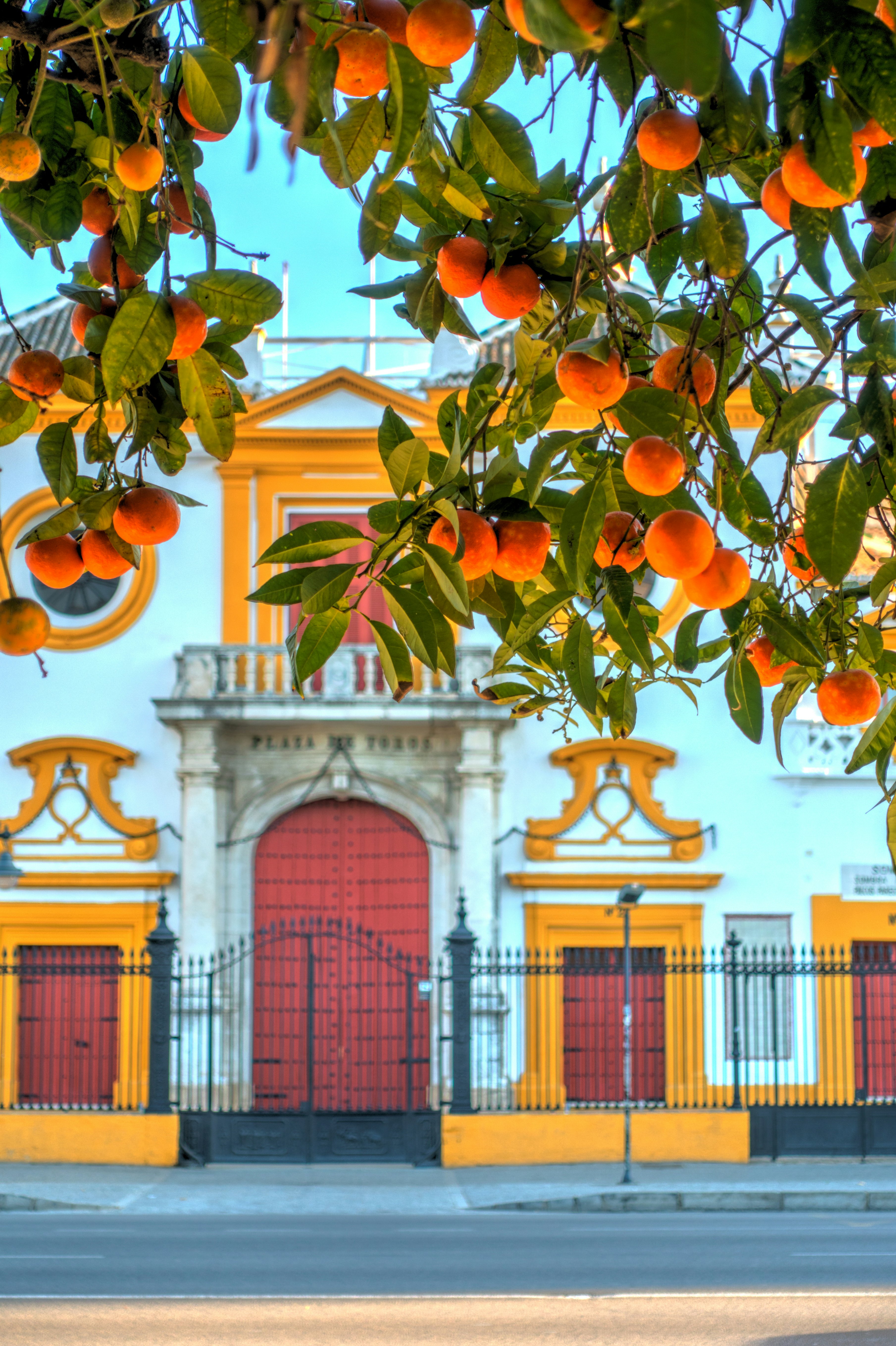
5. Two major spring festivals draw crowds to Seville
The spring shoulder season is becoming an increasingly popular time to visit Seville. Average temperatures climb above 15°C (60°F), the sights aren’t overcrowded and the orange blossoms perfume the whole city. But it’s worth noting that this season also welcomes Seville’s two biggest festivals. The first is Semana Santa (Easter Holy Week), which draws huge crowds to the streets to witness the various protests and events. Two weeks later, Andalucian customs and cuisine are celebrated with a good measure of drinking for the Feria de Abril. The dates for both change every year. You might well want to experience these joyous events for yourself, in which case, book as far ahead as possible. Otherwise, aim to visit either side of these parties to dodge the crowds.
6. Driving in central Seville is challenging
If you’re planning to rent a car and drive around Andalucía, it’s worth considering ditching the car for the Seville portion of your trip. Similar to other historic cities in the region such as Córdoba, the narrow streets, one-way system, pedestrianized zones and complete lack of parking all make driving a hassle. Besides, Seville is one of the best cities in Spain to explore on foot.
7. Don’t expect to find any dinner before 8pm
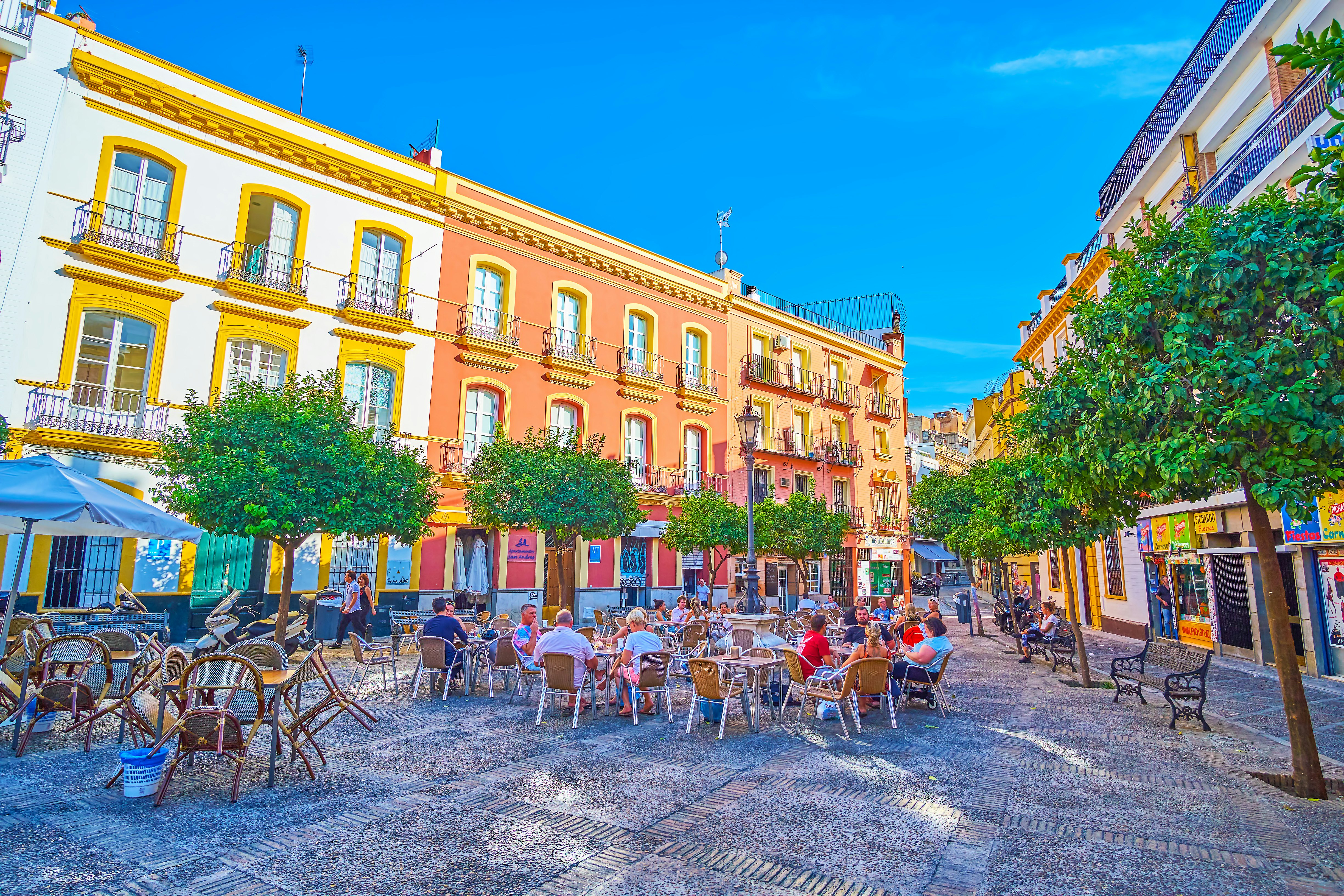
Mealtimes in Seville are short, sharp bursts of frenetic culinary activity that demand a rest period in between. As with most of Spain, restaurants in Seville are not set up to sate the hunger whenever it rises. Instead, kitchens open at very rigid and specific times with little exception. In most cases, doors will be closed until 8pm. By 9:30pm the place will be packed out, as the locals come out to eat a light dinner of tapas.
Lunch is the day’s main meal for most Andalucians, and takes place during a similarly rigid window of 1–3pm. If you’re accustomed to eating lunch or dinner at different times, buy some snacks at a supermarket such as Carrefour Express to keep you going.
8. An introductory cheek kiss is (mostly) the norm
When you’re introduced to a local, it can be rather surprising to see them coming in for a light peck on either cheek, particularly if you come from a place where personal space is a thing. If it’s between two men, a firm handshake is expected, but any other gender combination applies the two-kiss rule.
9. Seville’s LGBTIQ+ community is welcomed and celebrated
Like the rest of urban Spain, Seville is a culturally open-minded and liberal city where the LGBTIQ+ community is embraced. The city hosts the region’s biggest Pride parade – Orgullo de Andalucía in late June – and there are gay-friendly businesses throughout the city. The community’s hub is around Alameda de Hércules which is, unsurprisingly, Seville’s best nightlife area.
10. Tipping is appreciated but not expected
As with most of Europe, tipping in Spain isn’t mandatory. As a customer, you’re not expected to supplement somebody’s wages here. But giving a little extra at restaurants and tapas bars – 10% is adequate – is always appreciated, and often well deserved. You’ll soon discover that service in Spain during peak mealtimes is an art form that combines patience, endurance and the unique ability to balance a great amount of crockery while weaving through impossibly tight gaps in the crowd.
11. Drink more water than you think you need
Part of Seville’s allure to visitors is the hot and dry climate, meaning you’re less likely to travel all that way for rain to dampen the plans. But the caveat is that the heat is a dry heat. You might not realize how much you’re sweating, as it evaporates so quickly. Naturally, this means dehydration and heat stroke can creep up on you. Always carry at least a liter of water with you and drink little but often throughout the day.
12. Seville is generally safe, but…
While it always pays to be cautious and stay in control, Seville is considered to be one of the safest cities in Spain. From the tap water (which is completely fine to drink), to the low levels of pickpocketing and street crime, even at night, it’s acceptable to bring down your barriers in Seville. Of course, as with all human habitations, crime does exist, however rare it may be. Maintain vigilance of your belongings, particularly in the train and bus stations and during busy or crowded times, such as at festivals.








